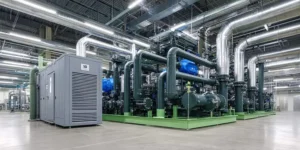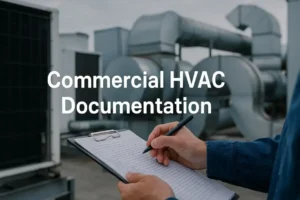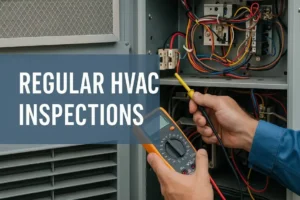Blog Contents
- 1 The Unique HVAC Challenges of Warehouses and Factories
- 2 Choosing the Right HVAC System for Large Spaces
- 3 The Role of Ventilation and Air Circulation in Industrial Settings
- 4 Energy-Efficient Solutions to Reduce Operating Costs
- 5 Preventative Maintenance: Keeping Large HVAC Systems Running Smoothly
- 6 The Benefits of Smart HVAC Controls for Large Facilities
Keeping a massive warehouse or factory comfortable isn’t as simple as adjusting a thermostat. Effective HVAC (Heating, Ventilation, and Air Conditioning) solutions must account for various factors such as airflow management, insulation, and energy efficiency to ensure a stable indoor environment. The right strategy is essential for maintaining productivity, protecting equipment, and keeping energy costs in check.
In this blog, we’ll explore the best ways to optimize HVAC systems for large commercial spaces. From choosing the right equipment to improving airflow and energy efficiency, we’ll cover key strategies to keep warehouses and factories comfortable while minimizing costs.
The Unique HVAC Challenges of Warehouses and Factories
Unlike homes or offices, warehouses and factories have complex HVAC needs. Some areas might be packed with workers, while others sit empty for hours.
Machinery generates heat, doors open and close constantly, and different products require different temperature conditions. Here are a few challenges that make HVAC design tricky for large industrial spaces:
- Size & Height: Large square footage and high ceilings make it harder to maintain consistent temperatures.
- Heat from Equipment & Processes: Factories with heavy machinery can generate intense heat, requiring cooling solutions.
- Ventilation Needs: Stale air and airborne contaminants can be a problem in industrial settings.
- Energy Costs: Keeping a large space heated or cooled can be expensive without efficient systems in place.
Choosing the Right HVAC System for Large Spaces
To effectively heat, cool, and ventilate a large commercial space, you need an HVAC system designed for the job. Here are some of the best options:
1. Rooftop Units (RTUs)
These all-in-one HVAC systems sit on the roof, keeping valuable floor space open. RTUs are excellent for large buildings because they provide:
- Easy maintenance access
- Modular expansion for growing spaces
- Energy-efficient heating and cooling options
2. Radiant Heating Systems
Instead of heating the air, radiant systems heat surfaces like floors and walls, making them ideal for warehouses with large open areas. This method is great for:
- Even heat distribution, especially in high-ceiling spaces
- Reducing heat loss from air movement
- Keeping workers comfortable in colder months
3. High-Volume, Low-Speed (HVLS) Fans
These gigantic ceiling fans help with air circulation and temperature control, making them a cost-effective supplement to HVAC systems. They:
- Improve airflow and reduce hot/cold spots
- Help maintain a consistent temperature with minimal energy use
- Reduce humidity levels in humid climates
4. Zoned HVAC Systems
By dividing a facility into different temperature zones, businesses can avoid wasting energy on unoccupied areas. This is especially useful for:
- Warehouses storing temperature-sensitive products
- Factories with sections that require different climates
- Spaces with varying workforce distribution
The Role of Ventilation and Air Circulation in Industrial Settings
Proper ventilation is just as important as heating and cooling. In warehouses and factories, poor ventilation can lead to stale air, excessive humidity, and even safety hazards from airborne pollutants. Here’s how to ensure proper ventilation:
- Use air exchange systems to bring in fresh outdoor air and remove stale indoor air.
- Invest in exhaust fans to eliminate fumes, smoke, and excess heat efficiently.
Good air circulation not only helps with temperature control but also improves indoor air quality—keeping workers comfortable and healthy.
Energy-Efficient Solutions to Reduce Operating Costs
Running an HVAC system in a large facility can be expensive, but there are ways to cut costs without sacrificing comfort.
1. Upgrade to Energy-Efficient Equipment
Newer HVAC systems are built for efficiency. Look for ENERGY STAR-rated units that offer:
- Higher SEER (Seasonal Energy Efficiency Ratio) ratings
- Variable speed technology for better temperature control
- Smart sensors to optimize operation
2. Use Smart Thermostats & Controls
Smart thermostats do more than adjust the temperature. They learn usage patterns, adapt to schedules, and integrate with automation systems to reduce energy waste.
3. Insulation & Sealing
A well-insulated warehouse or factory retains heat in the winter and keeps cool air in during the summer. Check for:
- Gaps around doors and windows
- Poorly insulated roofs and walls
- Air leaks in ductwork
4. Implement Demand-Controlled Ventilation (DCV)
DCV systems adjust ventilation based on occupancy levels, ensuring you’re not wasting energy when fewer workers are in the building.
Preventative Maintenance: Keeping Large HVAC Systems Running Smoothly
HVAC systems in industrial spaces work hard, and without regular maintenance, they can break down when you need them most. Here’s how to keep them running efficiently:
1. Schedule Regular Inspections
Have an HVAC professional check the system at least twice a year to catch potential issues before they become costly repairs.
2. Change Filters Frequently
Dust and debris can clog air filters, reducing efficiency and straining the system. Set a schedule to replace filters every 1-3 months.
3. Check Ductwork for Leaks
Leaks in duct systems can lead to significant energy waste. Sealing them properly ensures maximum airflow efficiency.
4. Clean Coils & Components
Dirty condenser and evaporator coils can reduce efficiency and cause the system to work harder than necessary. Regular cleaning prevents this issue.
By staying on top of maintenance, businesses can extend the life of their HVAC systems, improve performance, and reduce energy costs.
The Benefits of Smart HVAC Controls for Large Facilities
Integrating smart technology into HVAC systems is a game-changer. Smart controls can:
- Monitor energy use in real-time
- Automatically adjust settings for optimal efficiency
- Detect issues before they lead to system failure
- Provide remote access for easier management
Facilities using smart HVAC controls often see lower operating costs, improved comfort levels, and better overall system performance.
Optimize Your HVAC System with Expert Support
Maintaining HVAC efficiency in warehouses and factories is about more than just comfort—it’s about controlling costs, improving air quality, and keeping operations running smoothly. Whether you’re optimizing an existing system or planning a new installation, success starts with the right partner.
At B&H Heating and Air Conditioning, we specialize in commercial HVAC systems of all sizes. From routine maintenance that keeps your equipment running efficiently to designing and installing custom ductwork tailored to your space, our team is equipped to meet your facility’s unique needs. We’ll help you build a strategy that improves airflow, boosts energy efficiency, and supports long-term performance.
Ready to get more from your HVAC system? Contact B&H Heating and Air today to start the conversation.






